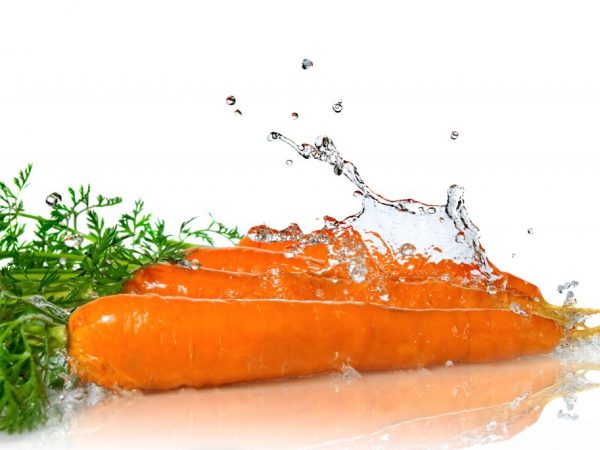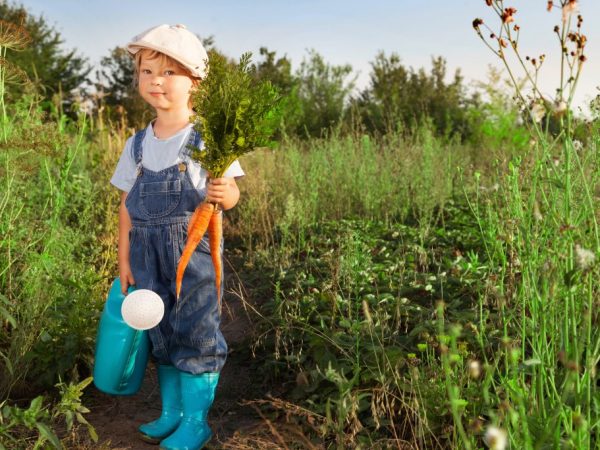Features of watering carrots after germination
To get a rich harvest of carrots, it needs to be cared for. Along with the correct selection of soil, fertilization and prevention of pests and diseases, you need to know how to water your carrots after planting.

Features of watering carrots after germination
Watering rules
Carrots need regular watering for good growth. Without moisture, the sprouts become weak and cannot withstand weather conditions, get sick and die off.
It is important that the seeds receive water during planting - this way they will sprout faster.
Soil moistening methods:
- They use the drip method, due to which moisture enters the soil in small quantities. The advantage is that the water does not wash out the seeds and gently moisturizes the soil without damaging the delicate sprouts.
- Hose watering is a more aggressive method. A strong pressure of water is able to wash out seeds and nutrients. Another effect is also possible - large drops will drive the seeds deeper into the ground, which will make the germination period longer and more difficult.
- The water coming to the beds from the watering can resembles rain, so this method is convenient to use. Moisture is evenly distributed over the soil surface, spares delicate seedlings, does not break stems and leaves. The amount of water can be easily adjusted.
Watering frequency
A feature of any kind of carrot is the late formation of the crop. At first, all the forces of the plant are spent on the growth and development of the green ground part of the culture, and the roots are formed already in the last quarter of the growing season - after 3-4 months. Therefore, during the period of active growth, vegetables require a lot of moisture in the soil, and at the end, before the harvest ripens, they do not tolerate its excess.
The lack of water in the soil with rare watering causes the accumulation of bitterness in the root crop, drying out of the core, the skin becomes tough. Excessive amount of moisture provokes increased growth of tops and cracking of root crops.

Don't water your carrots often.
Watering the carrots correctly follows a certain pattern:
- when the first shoots appear, water the beds on warm and sunny days every 4-5 days at 5 l / m²;
- in the middle of the growing season, when the root crop begins to form, water less often, but in large quantities - every 7-10 days at 8-10 l / m².
- in August, when the underground part has already taken shape, watering the carrots is done as needed (15-20 l / m²).
In the fall, 3 weeks before the start of the harvest, they stop saturating the soil with water so that the roots do not crack and begin to grow additional roots. Before harvesting, it is recommended to slightly moisten the beds to make it easier to dig out the crop.
By adhering to the schedule, there is a chance to prevent uneven plant growth and avoid problems with further storage of vegetables. The haphazard intake of moisture causes diseases with fungus and rot.
Recommendations for soil moisture
Watering carrots outdoors is advisable only with warm water. Cold can lead to weakening of the immune system, diseases and pests. If well water is used for irrigation, it is left in the sun to warm it up.Standing water and rainwater are also beneficial for crops.
Sometimes watering is combined with feeding root crops or prophylactic spraying against pests.
To do this, use different infusions and minerals that are harmful to insects. Disinfecting the soil is irrigated before sowing seeds: the beds are saturated with water with potassium permanganate (10: 1). The liquid acts as a top dressing, to which wood ash or other nitrogen fertilizers are added. Such procedures lead to the growth of sweet and large carrots.
Each row thinning injures the root system of the remaining crops. Therefore, it becomes necessary to slightly moisten the soil before starting work. After that, you need to water the beds abundantly in order to create conditions for a good strengthening of plants in the ground. Be sure to loosen the soil between the rows and near the stems of the crop after thinning to ensure the flow of air to the roots.
During periods of drought or heat in July and August, it is better to water the crops early in the morning or in the evening, when solar activity is slightly lower. On hot days, the beds are watered more often - up to 3 times a week, making sure that the moisture reaches a depth of 15-20 cm.
To preserve soil moisture, the spaces between the rows and around the tops are mulched using peat chips, finely chopped straw or hay, and sod. Mulch can help in seedling care by inhibiting the growth of weeds that feed on the moisture and minerals that vegetables need.
Conclusion
With proper care and watering, carrots can produce a rich harvest in all weather conditions. Adhering to a certain schedule of frequency and amount of soil moisture after planting, they control the taste and external characteristics of root crops, combine the function of plant care and prevention of diseases. Watering carrots in the open field should be in moderation, observing any changes.


